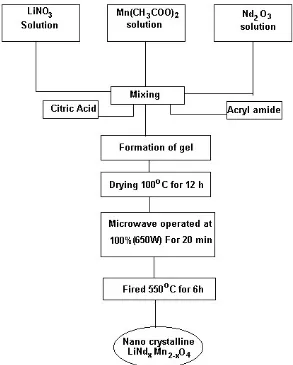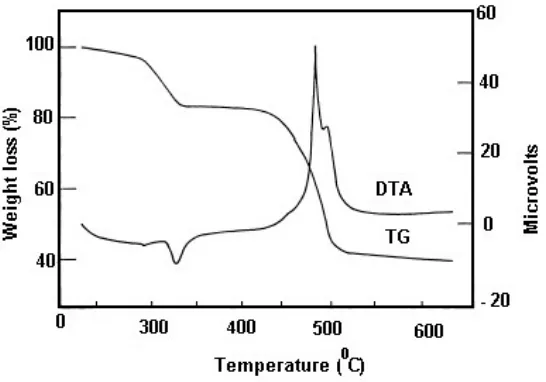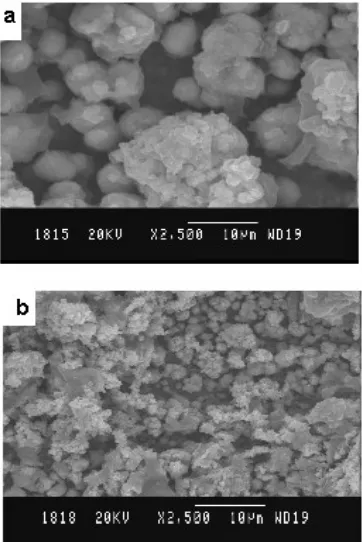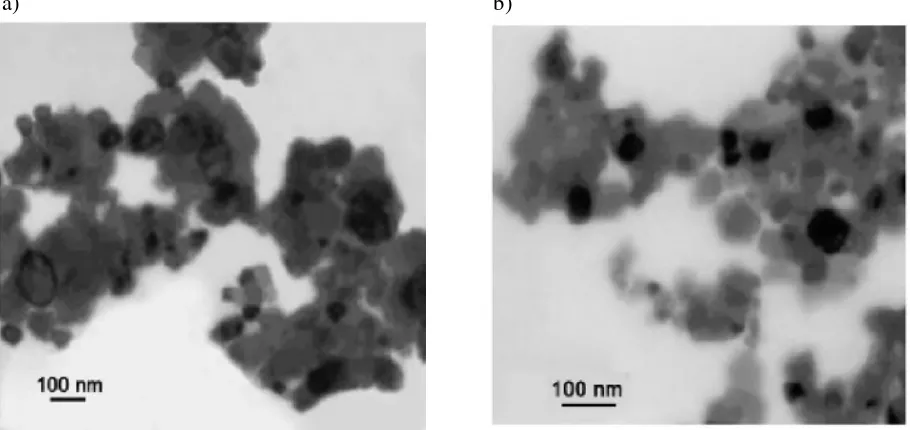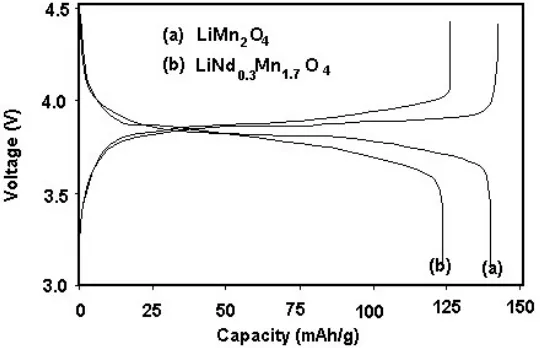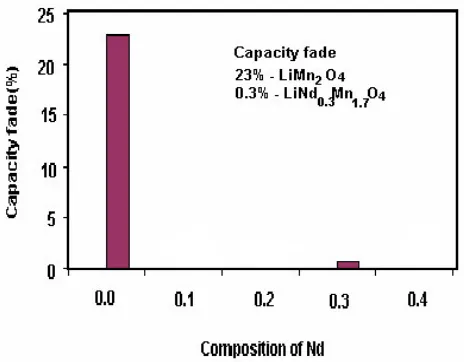(2008)
www.electrochemsci.org
Synthesis and Electrochemical Characterization of LiMn
2O
4and LiNd
0.3Mn
1.7O
4as Cathode for Lithium Ion Battery
K.Suryakala, KR.Marikkannu, G.Paruthimal Kalaignan* and T.Vasudevan
Lithium ion battery Research Lab, Department of Industrial Chemistry, Alagappa University, Karaikudi, Tamilnadu 630 003 India
*E-mail: kalaignan@yahoo.com
Received: 9 November 2007 / Accepted: 5 December 2007 / Online published: 20 December 2007
LiMn2O4 is inexpensive material but it shows rather poor cyclic performance. The electrochemical
performance of spinel type LiMn2O4 has been effectively improved with doping of Nd the “bottom–
up” approach of LiMn2O4 and LiNd0.3Mn1.7O4 synthesized by citric acid modified microwave assisted
sol-gel method. LiMn2O4 has been synthesized from nitrates and acetates. Citric acid was added as a
complexing agent and acryl amide acts as a gelling agent. This technique offers better homogeneity, preferred surface morphology, reduced heat-treatment conditions, sub-micron sized particles and better crystallinity. The structure and the electrochemical performances of the samples are characterized by X-ray diffraction, scanning electron microscopy, transmission electron microscopy, cyclic voltammetry and charge-discharge testing. XRD data shows both samples exhibit the same pure spinel phase. Nano crystalline LiNd0.3Mn1.7O4 sample has a smaller morphology including small particle
size and the homogeneous particle distribution.
Keywords: Li-ion battery; doped lithium manganese spinels; Structure, Cyclic voltammetry; Rare earth element
1. INTRODUCTION
Lithium ion batteries are well regarded as new promising power sources for both portable electronic devices and zero emission vehicles (ZEV) due to their longer cycle life and higher energy density than other rechargeable battery systems. Currently LiCoO2 [1], LiNiO2 [2] and LiMn2O4 [3]
are the main positive electrode materials for lithium –ion batteries. In comparison LiNiO2 and LiCoO2,
spinel LiMn2O4 has some advantages such as lower cost, higher abundance of Mn in the earth, high
700-900°C solid-state reactions starting from the raw materials, such as manganese oxides, nitrate or carbonate with lithium hydroxide, nitrate or carbonate. The final products usually contains larger irregular particle, in a broader size distribution, as well as impurity phases. And also, this method could not provide good control on the crystalline growth, compositional homogeneity, morphology and microstructure [6-9].Therefore, in order to overcome these disadvantages, various new techniques have been developed. Such techniques are based on the processes of co-precipitation, ion-exchange, or thermal decomposition at low temperatures of appropriate organic precursors obtained by sol-gel [10], Pechini [11], freeze –drying [12], melt-impregnation [13], or citric acid gel [14] methods. These methods lead to homogeneous spinel materials with small particle size at the low cost of expensive reagents and process complexity.
In this work, an attempt has been to stabilize the LiMn2O4 spinel structure by a Citric Acid
Modified (CAM) microwave assisted sol-gel method that employs citric acid as a chelating agent and acryl amide as a gelling agent with Co as dopant. This soft chemistry technique offers many advantages such as better homogeneity, low calcination temperature, shorter heating time, regular morphology, sub-micron sized particles, less impurities, large surface area, and good control of stoichiometry.
2. EXPERIMENTAL PART
2.1. Synthesis procedure
All the chemical reagents used in the experiments were analytical grade without further purification. LiMn2O4 and LiNd0.3Mn1.7 O4 powders were synthesized by Citric Acid Modified
microwave-assisted sol-gel method which is schematically represented if Fig1. A stoichiometric amount of lithium nitrate, manganese acetate and Neodymium oxide were dissolved in triple distilled water .A calculated amount of citric acid was added as a complexing agent followed by the addition of acryl amide. Here, the acryl amide acts as a gelling agent. The resulting solution was mixed with continuous magnetic stirring at 90°C until a clear viscous gel occurs. The obtained precursor was preserved under vacuum at 100°C for 12 h to eliminate water adequently and then was placed in microwave oven. The microwave power operated at 100% (650W) for 20 min. After the microwave treatment, the samples were calcined at 550°C for 6h, followed by cooling to room temperature slowly.
2.2. Physical characterization
The thermal decomposition behaviour of the LiMn2O4 and LiNd0.3Mn1.7 O4 precursor samples
were made using a simultaneous TG/DTA thermal analyzer (STA -1500) at the heating rate 10°C /min under ambient atmosphere. The purity and structural conformity of the powder was confirmed by JEOL X-ray diffraction analysis (JDX-8030) using Cu Kα radiation. The diffraction patterns were obtained at 25°C in the range 10° 2θ 70.The step size and scan rate were set at 0.1 and 2 °C min-1,
electron microscopy JEOL (JSM840A) and Transmission electron microscope JEOL – (JEM -100SX).
Figure 1. Flow chart for the preparation of cathode materials by CAM microwave assisted sol-gel method.
2.3. Electrochemical characterization
In order to assess the cycling behaviour of the synthesized cathode materials, cyclic voltammetry and charge / discharge studies were conducted by fabricating 2016 button –type electrochemical cells with the configuration of C/ LiMn2O4 and LiNd0.3Mn1.7O4 and employing Li+
ion conducting, LiClO4 electrolyte. The cathode was prepared by mixing synthesized powders,
[image:3.612.156.449.114.479.2]analyzer. The synthesized cathode electrodes were examined for their capacity by constant current charge / discharge at potential window 3.0 V – 4.5V at a constant current density of 0.1mA/cm2 using
WonATech Potentiostat/ galvanostat instrument (WPG100 South Korea).
3. RESULTS AND DISCUSSION
[image:4.612.176.449.271.462.2]3.1. Thermal analysis
Fig.2 shows the phase formation of LiMn2O4 begins at around 305 and 312°C followed by the
complete composition of precursor occurred at 425 and 450 °C, respectively. The above discussion revealed that the phase formation and /or complete crystallization of LiMn2O4 precursor of citric
acid-acryl amide combination occurs at lower temperature.
Figure 2. TG/TDA result on LiNd0.3Mn1.7O4
3.2. XRD studies
The XRD patterns of products are shown in Fig.3(a-b) The XRD patterns show that the spinel LiMn2O4 and LiNd0.3Mn1.7O4 powders have pure and crystalline in nature in all the compositions.
Impurities phases such as Li2CO3 and Mn2O3 are often formed in other low temperature synthesis
techniques [15] are not observed. The main diffraction peaks of cubic spinel LiMn2O4 phase, such as
(111), (311) and (400) are well developed. This means that lithium ions occupied tetrahedral 8a sites and manganese also occupied octahedral 16d sites.
3.3. SEM and TEM analysis
Particle morphology was examined by scanning electron microscopy which shows that both LiMn2O4, LiNd0.3Mn1.7O4 exhibit homogeneous particle distribution and relatively small particles
LiNd0.3Mn1.7O4 presented in Fig.4 (a-b). The well dispersed particles are the result of the treatment of
microwave as reported elsewhere [16] because the microwave heated not from the outside from inside of the precursor and thus provided a uniform heating environment which shortened the synthesizing time and overcome the synthesizing time and overcome the agglomeration of particles [17].Such kind of morphology is very important to both the high specific capacity and good cycleability of the materials [18-20]. The SEM studies reveal LiNd0.3Mn1.7O4 material to be of finer size and with less
[image:5.612.175.466.194.386.2]aggregation. It should be most suited cathode material for lithium ion batteries.
Figure 3. XRD patterns of (a) LiMn2O4 (b) LiNd0.3Mn1.7O4
[image:5.612.233.414.422.693.2]Hence TEM studies were carried out only for this particular composition to have more clarity on the particle size. The TEM photographs for undoped and LiNd0.3Mn1.7O4 synthesized at 550°C are
presented in Fig5 (a, b). In the case of undoped LiMn2O4 the cluster formation is 60nm and also the
particle size is little larger when compared with the Nd doped material 40 nm. The interlayer distance may be higher than that of the doped one due to the larger size of particles. The surface area of the electrode material is an important characteristic parameter that determines the energy and power density of a particular battery system. In the present study the surface area is expected to be higher for Nd doped cathode material because of lesser particle size.
a) b)
[image:6.612.80.535.225.440.2]
Figure 5. TEM photograph of (a) LiMn2O4 (b) LiNd0.3Mn1.7O4
[image:6.612.177.431.497.688.2]3.4. Cyclic voltammetry studies
The electrochemical properties Nd synthesized LiMn2O4 and LiNd0.3Mn1.7O4 were studied
through cyclic voltammetric technique. The cathode active materials (80%) were mixed with 10%: 5% weight percentage of acetylene black and polyvinylidene difluoride (PVDF) with N-Methyl-2-pyrrolidione (NMP) binder solution. The prepared paste was casts on pure Al foil and cured at 110°C in a vacuum condition for 24 hours. A standard 2016 type coin cell was made using graphite as anode and synthesized material as cathode with polypropylene separator. The electrolyte used 1M LiClO4 EC
(ethylene carbonate) (1:1 v/v). All the setup was done in the argon filled glove box. The cyclic voltammetric properties of the cells were examined between the potential window of 3.0 and 4.5V and the resulting voltammograms are presented in Fig. 6(a, b).The intercalation and deintercalation of lithium conveniently takes place in the potential range of interest in all the synthesized materials. Interestingly, the sample prepared x = 0.3 shows a well decreased Ep and thus supports the inseration –deinsertion process to be easier.
3.5. Charge –discharge studies
The charge –discharge studies were performed at a constant current density of 0.1 mA/cm2 in
the potential range 3.0 – 4.5 V. The recorded voltage capacity curves are shown in Fig 7(a,b) and Fig 8. The first discharge curves show the capacity retention is higher for lower addition while at higher addition the capacity retention is much reduced. In the 50th cycle, the capacity retention is 99.5% for x
= 0.3; However, for undoped material capacity retention is only 83%. Alternatively the capacity fading rate of doped and undoped LiMn2O4 materials depicted in Fig. 9 as bar chart where one could see
LiNd0.3Mn1.7O4 cathode material for lithium battery application with capacity fading rate (0.3%) too
low when compared toLiMn2O4 (16%%). The above discussion revealed that the nano-crystalline
LiNd0.3Mn1.7O4 has very good reversibility when compared to undoped LiMn2O4.Because the smaller
particle size of LiNd0.3Mn1.7 O4 facilitates rapid diffusion of Li+ ions which leads to good battery
[image:7.612.163.433.525.699.2]performance.
Figure 8. Plots of specific capacity vs. cycle no. of LiMn2O4 and LiNd0.3Mn1.7 O4
Figure 9. Capacity fading rate vs. in LiMn2O4 and LiNd0.3Mn1.7O4
4. CONCLUSIONS
Nano-crystalline phase pure LiMn2O4 and LiNd0.3Mn1.7O4 powders have been synthesized in
bulk quantities by CAM microwave assisted sol-gel method. In this study, the rare earth element Nd3+
was used as dopant in the LiMn2O4 and the structure and the electrochemical properties were
examined. XRD data showed that the Nd3+ doped sample has the similar phase with undoped sample,
but has larger lattice parameter than that of the undoped LiMn2O4. Thermal studies and TEM studies
show that LiNd0.3Mn1.7O4 at lower temperature with smaller nanoparticles. An electrochemical
investigation also shows that the product obtained by LiNd0.3Mn1.7O4 yield better capacity retention
than the undoped LiMn2O4.
Hence, LiNd0.3Mn1.7O4 is the effective composition in CAM microwave assisted sol-gel
[image:8.612.184.416.278.459.2]References
1. Z.Chen, J.R. Dhan, Electrochim. Acta 49 (2004) 1079 2. J.Maruta, H.Yamachi, J.Power Sources 90 (2000) 89
3. X.He, J.Li, Yancaj, C.Jiang, C.Wan, Mater.Chem Phys. 95 (2006) 105 4. M.Wu, Q.Zhang,H.Lu,A.Chen,Solid State Ionics 169 (2004) 47
5. Y.-S. Lee, Y.-K.Sun, K.-S.Nahm, Solid State Ionics 109 (1998) 185 6. Y.Gan, J.R.Dahn, J.Electrochem.Soc. 143 (1996) 100
7. P.Endres, B.Fuchs, S.K.Sack, K.Brandt, G.F. Becker, H.W. Praas, Solid State Ionics 89(1996)221 8. A.Momchilov, V.Manev, A.Nassalevska, A.Kozawa, J.Power Sources 41 (1993) 303
9. J.Guan, M.L.Liu, Solid State Ionics 110 (1998) 21
10. W.Liu, K.Kowal, G.C.Farrington, J.Electrochem.Soc. 143 (1996) 3590 11. W.Liu, G.C.Farrington, F.Chaput, B.Dunn, J.Electrochem.Soc. 143 (1996) 879 12. E.N.Zhecheva, M.Y.Gorova, R.K.Stoyanova, J.Mater. Chem. 9 (1999) 1559 13. Y.Y.Xia, H.Takeshige, H.Noguchi, M.Yoshio, J.Power Sources 56 (1995) 61 14. B.J. Hwang, R.Santhanam, D.G.Liu, Y.W.Tsai J.Power Sources 102 (2001) 326 15. B.J.Hwang, R.Santhanam, D.G.Liu, J.Power Sources 101 (2001) 85
16. S.T.Yang, Y.F.Zhang, Q.Z.Lv, J.Inorg.Mater. 15 (2000) 312 17. H.Yan, X.Huang, L.Chen, J.Power Sources 81 -82 (1999) 647
18. F.K.Shokoohi, J.M.Tarascon, B.J.Wilkers, D.Guyomard, C.C. Chang, J.Electrochem.Soc. 139(1992) 184
19. S.W. Jang, H.Y. Lee, K.C. Shin, S.M. Lee, J.Power Sources 88 (2000) 274 20. S.T.Myung, H.T. Chung, S.Komaba, N.Kumagai, J.Power Sources 90 (2000) 103
